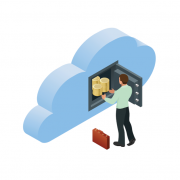A runaway train to the cloud: should medium-sized players join the chase?!
Small and medium-sized organizations in the banking sector have been interested in the cloud for quite some time now. They witnessed the collaboration of their big cousins with technology giants: IBM with Bank of America, Google with GP Morgan. Feeling that the transition to the cloud is irrevocable, many of these medium-sized and small banks still plan to carry out this transformation themselves. But is this the right path to take?
Cloud’n’play: the future of banking?
The transition to the cloud is a revolution of a much greater size than the emergence of the core systems 20 years ago. Back then, the leap was contained only inside of the realm of the banking world. Now the banks are transforming in the hope of becoming hubs for all matters of life, not only finances.
This is because In their strive towards improved customer experience, the e-commerce giants such as Amazon or Google have stepped into the realm of payments. They proved that they are technically savvy enough to handle payment processing, and to do it well, i.e. exceeding customer expectations. In response, banks have spotted the red flags and dashed after the runaway train. Their agenda is not only to improve their CX to match that of e-commerce’s, but also to expand their offer with services in such a way that will keep e-commerce at bay. The new standard of banking will include insurance services, investment consulting, or any finance-related service, that Amazon is new to. However, to withstand the competition of agile e-commerce, banks need more than even a top-class core system. What they need is an entire ecosystem of integrated applications – no longer on-prem, but in the cloud.
In the new ecosystem, each mobile banking application is to bring benefit to the customer and to be standardized. In some time, Apple Store or Google Play will offer several dozen applications meeting all customer needs, not only those related to finance. With standard interfaces, the application can “plug’n’play” into the bank’s IT architecture, regardless of the manufacturer. And when a revolutionary fintech application comes up on the market, a “cloud-native” bank will be able to buy it, connect it to their servers and offer the service to the customer via a plug, available for download in an ordinary app store.
In my opinion, this is what the banking of the future will look like in the cloud model. The clients “plug” the preferred application package into the architecture of the selected bank, and “uninstall” as they wish. In such an arrangement, the bank will do everything to encourage customers to “plug in” with them, and not with their competition. To retain the customer, the existing central systems must become at least “plug’n’play-ready”, either natively or via adapters. There is only one “but” – no mature central banking system in the world is ready for this yet.
Is the runaway train worth chasing?
Of course, there are visionary solutions such as @Frank Sanchez’ Finxact, a cloud-native Core as a Service. In March this year, the new digital banking app One and FirstBank operating in western US announced that they chose Finxact to power their services. In late 2019, Finxact launched cooperation with the US Clearing House (TCH) to bring real-time payments capabilities to its customers through the RTP® network, a new payment network financial institutions can use to clear and settle real-time consumer and business payments.
Finxact initiative is a big leap towards genuine cloud freedom, but it still has a long way to go, as does all the industry. Perhaps, since the system was designed natively for the cloud, its “plug’n’play” features will allow it to supplement any missing functionalities with third party cloud native plugins? In the meantime, what are small and medium-sized banks to do? First of all, they don’t have a core system that could handle cloud solutions well. The solutions available so far have limited functionalities, but over time we can expect core system upgrades to the cloud, with several pre-integrated applications.
FIS, a leading technology provider for the financial world, recently announced that it already has 74 external SLA-guaranteed applications ready for its cloud-ready core system. Still, replacing the core system, or even upgrading its version, is a multi-million dollar investment, which amortizes within a dozen or so years.
When faced with such decisions, banks, especially medium and small-sized, will probably try to patch up the old systems with makeshifts. However, for some operations, these temporary solutions will not be enough. In-house solutions will certainly not be able to compete with the proposals of those players who join ranks with Amazon, Google and Facebook. How will this translate into customer satisfaction? I’m sure the customer will vote with their feet. As a result, within 12 years time, 80% of financial firms will either go out of business or be rendered irrelevant by new competition, changing customer behaviour and advancements in technology, according to forecasts by Gartner.
The giants have enormous money sacks, which they use easily when there is a potential to earn even more in the future. With modern solutions in place, the largest players will be able to adapt to the client overnight, at the same time dividing and conquering the market among themselves and leaving no room for third-party competition. It will impact business partners, customers and IT suppliers of minor players. The question is not if it happens, but when.
Focus on the customer, and not on the chase
However, traditional banking is not without a chance. In its fervor of chasing the next exciting technology the top players can actually lose their touch with reality and the customer will be lost on the way. This is where the banking model based on a proven, long-term partnership has the upper hand. While a part of society feels good about constant change, it is still in the minority, albeit growing. The latter part is focused on stability and gradual evolution. After all, the average length of a relationship with a bank in the UK is 17 years, often longer than a marriage!
Before the central system vendors are ready with the product and the race leaders reach the “cloud’n’play level”, customer satisfaction is the safest bet. Instead of building virtual worlds, it is worth putting your efforts into a relationship with the client and showing that it is you who is trying harder. There already is a way to genuinely care for the customer, and have them attached enough so that they won’t change ship in the first wave to come as soon as Google Pay offers them a bank account.
How to emerge a winner?
I believe the quick wins strategy is most effective. The clients will feel appreciated when they notice the bank cares for them through frequent, yet not necessarily major, improvements and changes.
Our proprietary system Payres is based on this idea. It activates banking data in real-time and keeps the customer engaged, or even appreciated thanks to push notifications. The bank is following the e-commerce trends we got us accustomed to – instant response combined with proximity.
The point is not to give up the cloud altogether, but to think about which applications are crucial from the bank’s point of view, and to have them ready when the time comes. Meanwhile, you can consider redirecting the flow of investments from the cloud race to pro-customer solutions.
If you want to learn more about how the Payres system works, or talk about cloud solutions for banking, do not hesitate to contact me!


